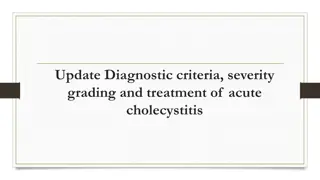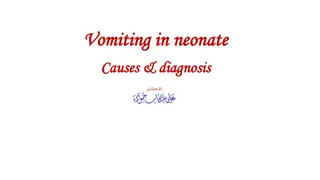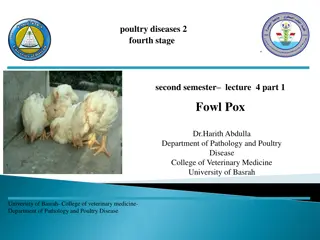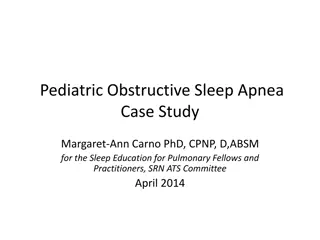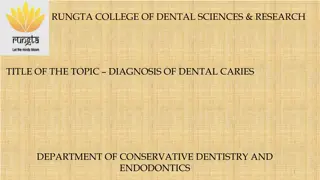Vaginitis and Vulvovaginitis: Diagnosis and Management
Vaginitis and vulvovaginitis are common inflammatory conditions affecting the vagina and vulva, often caused by disruptions in normal flora or pH levels. Key pathogens include bacteria like Gardnerella vaginalis, fungi such as Candida species, and parasites like Trichomonas vaginalis. Bacterial vaginosis, candidiasis, and trichomoniasis are the primary infections diagnosed in women of reproductive age. Understanding the causes, diagnosis, and management strategies for these conditions is crucial for effective treatment and prevention.
Download Presentation

Please find below an Image/Link to download the presentation.
The content on the website is provided AS IS for your information and personal use only. It may not be sold, licensed, or shared on other websites without obtaining consent from the author.If you encounter any issues during the download, it is possible that the publisher has removed the file from their server.
You are allowed to download the files provided on this website for personal or commercial use, subject to the condition that they are used lawfully. All files are the property of their respective owners.
The content on the website is provided AS IS for your information and personal use only. It may not be sold, licensed, or shared on other websites without obtaining consent from the author.
E N D
Presentation Transcript
Laboratory Diagnosis of Laboratory Diagnosis of Vaginitis Vaginitis
Termonology and Pathogenesis Vulvovaginitis, Vulvovaginitis, vulvitis Are general terms that refer to the inflammation of the vagina and/or vulva Normal flora Normal flora Lactobacilli Changes in the vaginal acidity or disturb the normal bacteria in the vagina may predispose to an infection . vulvitis, and vaginitis , and vaginitis
Characteristics of the Vagina and Cervix in Women of Reproductive Age Vagina Vagina Cervix Cervix pH <4.5 7.0 Epithelial cells Squamous Columnar Pathogens/ Syndrome Bacterial vaginosis Candida species Trichomonas vaginalis Neisseria gonorrhoeae Chlamydia trachomatis
VAGINOSIS /VAGINITIS Most common reason for patient visit to OB/GYN. Three primary infections in order of prevalence: Bacterial vaginosis Candidiasis Trichomoniasis
Causes of vulvovaginitis Bacterial : Bacterial : Bacterial vaginosis (40%) Fungal : Fungal : Candida vulvovaginitis (25%) Parasitic : Parasitic : trichomonal vulvovaginitis (25%) Low estrogen levels Low estrogen levels (called "atrophic vaginitis") Allergic or irritation or injury response Allergic or irritation or injury response from spermicidal products, condoms, soaps, and bubble bath called contact vulvovaginitis .
History General medical Hx Allergies DM Malignancies Immunodeficiecy Medication OCP<steroids, duches Symptoms General gyneclogical history Menstrual history Pregnancy Sexual Hx Contraception Sexual relationship Prior infection
Bacterial Vaginosis Most common of vaginal syndrome A change in the balance of normal vaginal bacteria . Very high numbers of bacteria such as Gardnerella vaginalis, Mycoplasma hominis, Bacteroides species and Mobiluncus species. In contrast, Lactobacillus bacteria are in very low numbers or completely absent.
Clinical Features Itching and burning. Fishy-smelling (specially after sexual intercourse and menses) thin, milky- white or gray vaginal discharge.
BV Sequelae OB complication OB complication Preterm delivery Premature rupture of membranes Amniotic fluid infection Chrorioamnionitis Postpartum endometritis Premature labor Low birth weight GYN Complication GYN Complication Pelvic inflammatory disease (PID) Postaportal pelvic inflammatory disease Posthysterectomy infections Mucopurulent cervicitis Endometritis Increased risk of HIV/STD
Diagnosis Related symptoms and sexual history. Examination of introitus may reveal erythema of the vulva and edema of the labia. Speculum examination. A sample of the vaginal swab.
Office Diagnostics for Vaginitis Empiric diagnoses often inaccurate and lead to incorrect treatment and management. Need for rapid, accurate and inexpensive diagnostic tests.
OFFICE-BASED TESTS FOR VAGINITIS ARE UNDERUTLIZED Simple, inexpensive, office-based tests were underutilized. Microscopy PH measurement Whiff amine test
CLINICAL DIAGNOSIS OF BV Clinical diagnosis. 3 out of 4 of these criteria. _____________________________________ 1. PH greater than 4.5 2. Positive Whiff test 3. Any clue cells 4. Homogenous discharge.
Gram Stain Diagnosis Predominance of lactobacilli = normal. mixed small gram-positive and gram-negative rods curved rods = BV.
PH TEST PH indicator strips: pH 3.5 - 7.0 Place sample of vaginal secretion on test strip: read while still moist. PH>4.5 indicates abnormality (i.e. BV- Trichomonas- or menstrual blood). Be careful not to sample the cervix; cervical secretions and blood have a PH 7.0.
KOH "WHIFF" TEST Sample of vaginal secretions are placed in a test tube with 10% KOH. KOH alkalizes amines produced by anaerobic bacteria-results in a sharp "fishy odor"
WET MOUNT PREPARATION Vaginal secretion sample from the anterior fornix and lateral wall Place swab in test tube with small amount of normal saline and place sample on glass slide with cover slip Visualize at both low and high power Clue cells, yeast, trichomonas, WBC, bacteria.
CANDIDIASIS Overgrowth of a normal inhabitant of the vagina. Predisposing factors: Pregnancy , DM, Immunocompramized conditions, antibacterial treatment . Clinical Presentation : Irritation, pruritus, soreness, painful sexual intercourse burring on passing urine, and a thick, curdy, white (like cottage cheese) vaginal discharge.
Diagnosis of VVC Wet prep to see clumps of pseudohyphae. Budding yeast and no pseudohyphae in patients with C glabrata. KOH prep helpful but not always necessary.
Vaginal Yeast Cultures Probably not routinely indicated - many women are colonized with Candida If obtained must correlate with patient signs and symptoms For recurrent infections culture and susceptibility testing may be helpful
TRICHOMONIASIS Sexually transmitted parasite Trichomonas is the most prevalent non-viral sexually transmitted disease (STD) agent.
Clinical Features Vaginal discharge, pruritus in females, but may be asymptomatic. Painful urination, Painful sexual intercourse A malodorous smelling yellow-green to gray, sometimes frothy, vaginal discharge. Males usually asymptomatic, but can cause Non-gonococcal urethritis .
Trichomonas Complications Trichomonas associated with: o Premature rupture of membranes o Preterm labor and birth o Low birth weight o Increased transmission of other STDs including HIV
Culture is considered the gold standard for the diagnosis of trichomoniasis. Its disadvantages include cost and prolonged time before diagnosis
Other Methods of Diagnosis EIA Sensitivity 91.6% Specificity 97.7% DNA Probe
Clinical syndrome Clinical syndrome Etiology Etiology Treatment Treatment Bacterial Bacterial vaginosis Malodorous vaginal discharge, pH >4.5 vaginosis Etiology unclear: associated with Gardenella vaginalis mobiluncus, Prevotella sp., Metronidazole Metronidazole Tinidazole Trichomoniasis Trichomoniasis Copious foamy discharge, pH >4.5 Treat sexual partners Trichomonas vaginalis Metronidazole Metronidazole Tinidazole Candidiasis Candidiasis Pruritus, thick cheesy discharge, pH <4.5 Candida albicans 80-90%. C. Glabrata, C. tropicalis Oral Oral azole azole: : Fluconazole Fluconazole Itraconazole







